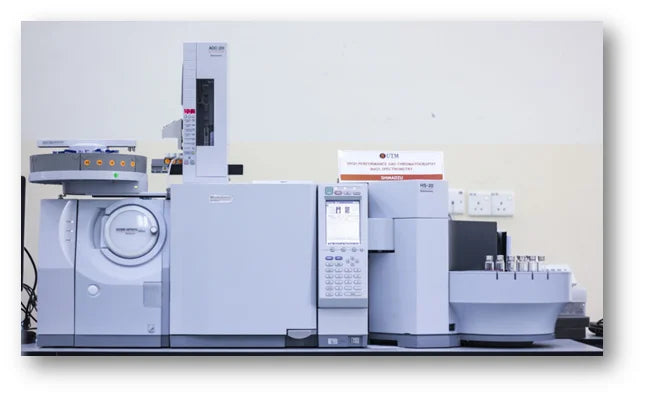When you get a new bottle of perfume, you carefully unbox it. You place it on a soft tablecloth for the first time so that the bottle containing it does not suffer any nicks. It must stay pristine.
You carefully swivel the cap and unravel a completely new world. You patiently, yet amusingly, absorb the fragrance floating out of the bottle right into your nostrils. Evidently, you are transported to a whole new world.
However, making sure you get this level of excitement from something so naive as a bottle of perfume is quite difficult. It all falls into the hands of perfume makers. Creating a perfume with an assortment of fragrances amalgamated together to fuse a pleasant smell into a tiny bottle is not an easy task as it seems to be.
However, the development of technologies ensures that the process gets easier. And GC/MS (Gas Chromatography-Mass Spectrometry) plays a huge role.
But before we delve into the depths of how the evolution of GC/MS has boosted the perfume-making process, you need to learn what GC/MS is.
What is GC/MS?
GC/MS combines two scientific methods together to identify substances within a test sample. It is a combination of gas chromatography and mass spectrometry.
It’s a highly effective method to determine substances from a test sample. It is mostly used in forensics. Apart from that, GC/MS is also used for drug detection, fire investigation, environmental analysis, investigation of explosives, and identification of unspecified samples.
1Gas Chromatography and Mass Spectrometry Diagram
GC/MS has also been used to analyze samples collected from Mars’ surface in the past.
GC/MS is especially effective in perfumery. And this is why. According to Wikipedia, “GC-MS has been regarded as a ‘gold standard’ for forensic substance identification because it is used to perform a 100% specific test, which positively identifies the presence of a particular substance. A nonspecific test merely indicates that any of several in a category of substances is present. Although a nonspecific test could statistically suggest the identity of the substance, this could lead to false-positive identification.”
Perfumes are usually created with a combination of different components. To ensure long-lasting effects on the skin, perfume makers need to regularly develop new combinations. GC/MS helps in analyzing the different components in a perfume.
According to InnovaTechLabs, there are five ways this analytical technique can help perfume makers:
● Quality control of raw materials and ingredients, and the final product.
● Product development.
● Troubleshooting fragrances that are giving off unknown or unanticipated smells.
● Reverse engineering to gain a competitive edge.
● Understanding how storage conditions (i.e. exposure to heat, cold, light or darkness; or packaging types) affects aroma.
Using GC/MS in making perfumes
In order to extract the volatile and semi-volatile compounds from a perfume, headspace analysis is used. This is done, in turn, using GC/MS.
There are two kinds of headspace analyses, according to InnovaTechLabs:
Static Headspace Analysis
Dynamic Headspace Analysis
“Static headspace analysis can offer a more accurate depiction of how perfume is actually used. However, only a small fraction of the sample makes it into the GC column, so it’s typically used when a sample has high concentrations of compounds.”
While dynamic headspace analysis is the opposite:
“Dynamic headspace analysis allows more headspace vapor to travel to the GC column, while also leaving behind water that could degrade the analysis. However, the typical sensitivity for compounds analyzed by dynamic analysis is a nanogram per gram.”
The evolution of GC/MS
In order to understand the evolution of GC/MS with respect to perfumes, it is essential to understand the evolution of GC/MS itself. Both go hand in hand with each other. Moreover, involvement with perfumery is just one of the applications of GC/MS.
According to the American Chemical Society, the beginning of GC/MS was a mere science-fictional appearance. It was hinted as an object identification device in Star Trek and was used by the character Mr. Spock. However, this is where it actually set off.
“The technology had its start 60 years ago in Midland, Michigan, with the pairing of two powerful analytical techniques — gas chromatography (GC) and mass spectrometry (MS). By coupling the ability of GC to separate a chemical mixture with the ability of MS to identify its components, the new, combined technique proved revolutionary. GC-MS is now routinely used for speedy analysis in forensics, environmental monitoring, drug testing of athletes, and other applications.”
Avoiding technicalities, let me explain this to you in a simple manner. Sir Joseph John Thomson of The University of Cambridge was studying how atoms and molecules work, and in turn, happened to create a primitive version of MS.
Sir J.J. Thomson
At the time, gas chromatography was an unknown concept. However, mass spectrograph had been introduced. Sir J.J. Thomson’s assistant, Francis W. Aston later created a practical model of mass spectrograph and won a Nobel Prize for it.
By the mid-20th Century, advanced MS devices became available.
Gas spectrometry was later introduced in 1951-52 by Anthony T. James and Archer J.P. Martin of the National Institute of Medical Research in London. This discovery later gave rise to commercially viable models of GC.
However, the real development in terms of what we see today started in 1950, when Fred Lafferty and Roland Gohlke enhanced the power of GC by joining it with MS. According to ACS, “Adding MS allowed each component exiting the gas chromatograph to be analyzed separately.”
“GC-MS is an essential technology in modern analytical chemistry labs. Applications include the development of new pharmaceuticals and analysis of their purity, detection of chemical warfare agents and explosives, screening of athletes’ urine for banned performance-enhancing substances, and analyzing soil samples on Mars. Portable units can now be carried in one arm for on-site analysis, bringing us closer than ever to Star Trek’s vision.”
Perfumery got aboost with GC/MS
Since perfumes are mostly made up of non-volatile products, identifying them to ensure proper regulation is of paramount importance. Perfumes are also used in detergents, hair shampoos, and other home and personal care products.Before GC/MS was introduced in the 1960s, it was extensively difficult to determine components in a perfume’s composition. Manufacturers had to rely on olfactory tests and they weren’t much efficient.
However, in a separate chain of incidents, the European regulations implied in the 1990s that perfumes needed to be regulated. It was necessary because of two primary reasons. First: since perfumes contain a lot of ingredients, they must be checked for allergens. Second: since perfumes are usually directly applied to the skin, improper inclusion of ingredients could prove harmful.
The IFRA (International Fragrance Association), the global institution responsible for issuing and updating, since 1973 the Code of Practice for the fragrance industry, says that any ingredient used in the production of fragrances must be properly sampled and tested.
This gave rise to the need of GC/MS machines in the perfume industry. And it paved a path for a better future over the years.
At the most basic level, GC/MS brought some positive improvements.
1. Cost analysis of perfumes became possible. Since every component on its own, in a perfume, holds a definitive value; it’s important to price the perfume based on the sum of the values of all the components included. Cost analysis was possible even before GC/MS, but it wasn’t accurate since most components couldn’t be identified. Now that we have GC/MS to the rescue, the perfume industry is slowly growing to become over a 30-Billion-dollar industry in the coming years.
2. Quality control of perfumes have become more accurate making companies more compliant in the eyes of regulators and deemed fit for accruing profits.
3. Further developments in perfumes have accelerated since identifying the included components has become faster. This indicates that demand can be met by easily increasing the supply profiting everyone.
The advent of GC/MS has been magical for the perfume industry. However, recent developments in technologies suggest that GC/MS works better when coupled with yet another analytical method called LC/MS (Liquid Chromatography – Mass Spectrometry). This is because perfumes and fragrances contain both volatile and non-volatile components. While volatile components can be easily identified using GC/MS, it isn’t quite suitable to effectively identify non-volatile components.
That’s when LC/MS kicks in. And this is boosting the pace at which the perfume industry is growing.




